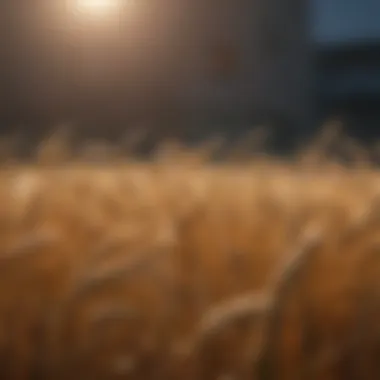Diverse Wheat Seed Varieties: Importance and Innovations


Intro
Wheat, a staple in diets across the globe, is as diverse as the cultures that cultivate it. From the pancakes in a Western breakfast to the naan accompanying a traditional Indian meal, wheat seed varieties form the backbone of global food security. Understanding these varieties is not just an academic exercise; it is vital for sustaining populations, advancing agricultural practices, and addressing the challenges posed by climate change and economic pressures.
This article takes a closer look at the myriad wheat seed types, their importance in our diets, and the unique traits that make them suitable for different environments. We'll delve into the cultivation practices tailored to each type and explore the recent advances that are reshaping wheat farming. With climate change knocking on the door, innovative breeding techniques are rising to the occasion, ensuring that farmers have access to resilient varieties that can thrive even under adverse conditions.
The conversation around wheat is no longer just about yield; it also involves sustainability, genetic diversity, and the importance of preserving many traditional varieties that are at risk of disappearing. Through this exploration, we aim to equip not only farmers but also researchers, educators, and enthusiasts with the insights necessary to navigate the complex world of wheat cultivation.
Whether you're a student eager to understand the science behind this essential grain or a professional seeking updates on the latest innovations in wheat breeding, this guide has something to offer. Let's embark on this journey through the fascinating terrain of wheat seed varieties.
Prelims to Wheat Seeds
Wheat stands at the forefront of global agriculture, serving as a staple food for countless populations across the globe. In examining wheat seed varieties, it becomes evident that understanding these seeds is not just a matter of agricultural practice but also a cornerstone of food security. Wheat seeds come in an array of varieties, each possessing distinct characteristics that can affect yield, disease resistance, and nutrient availability. This section delves into the intricacies of wheat seeds, shedding light on their significance and the nuanced diversity among them.
Overview of Wheat
Wheat is a cereal grain from the plant Triticum, and it's one of the most widely cultivated crops in the world. It thrives in various climates and soils, making it a versatile choice for farmers. What might astonish some is that wheat varieties can be as different as night and day. For example, durum wheat is primarily used for pasta, while soft wheat is ideal for cakes and pastries. Each type requires specific conditions for optimal growth.
Moreover, wheat has been integral to human civilization for thousands of years. The oldest evidence of wheat cultivation can be traced back to the Fertile Crescent. Since then, its cultivation has expanded worldwide, adapting to different agricultural practices and climate conditions.
Importance of Seed Varieties
Diversity in wheat seed varieties is akin to having a toolbox brimming with specialized tools. Each variety offers unique traits that enhance resilience against diseases, pests, and changing climate conditions. This biodiversity is essential for sustaining agricultural productivity over time. Here’s why seed varieties matter:
- Adaptive abilities: Different wheat seeds often possess varying levels of resistance to diseases like wheat rust or pests like aphids.
- Economic factors: Some varieties yield better returns due to higher market demand. Specialty wheats can fetch higher prices, benefiting farmers economically.
- Sustainability: By rotating different wheat varieties, farmers can reduce soil degradation and maintain ecological balance.
As noted by the Food and Agriculture Organization, *"Plant genetic resources are the ultimate source of food security and nutrition for all humanity."*
In summary, understanding wheat's diversity allows for better crop management and sustainable practices that fortify food security globally. This article’s exploration of wheat seed varieties will not only illuminate their characteristics and significance but also the innovations shaping the future of wheat cultivation.
Types of Wheat Seeds
When it comes to understanding the role wheat plays in agriculture and food security, diving into the types of wheat seeds is crucial. Each variety has its own unique traits, which influence not only the agricultural practices but also the end products we see in everyday life. The importance of various wheat seed types underlines the adaptability of wheat to different climates, soil types, and production practices. Grasping this knowledge aids farmers, researchers, and students alike in making informed decisions about cultivation and breeding, ultimately affecting food availability.
Bread Wheat
Bread wheat, scientifically known as Triticum aestivum, is the most widely grown type of wheat in the world. This wheat variety is versatile; it finds its way into everyday products like bread, pasta, and bakery goods. Its significance lies in its high gluten content, which provides elasticity and helps dough rise, making it a baker's best friend.
One notable characteristic of bread wheat is its strong adaptability to diverse environmental conditions. It can thrive in mild to temperate climates and, importantly, can handle varying soil types. This allows farmers around the globe to cultivate it successfully, thereby contributing significantly to global food security.
Durum Wheat
Next up is durum wheat, or Triticum durum, which stands out as the hardest wheat variety with a high protein content. Considered ideal for pasta production, durum wheat’s firm consistency after cooking helps retain shape, making it the backbone of traditional Italian pastas, as well as couscous.
The unique characteristics of durum wheat include its yellow semolina flour, which also imparts a distinct flavor and color to food. However, it requires a more specific growing environment, favoring well-drained, arid regions. Farmers need to be keenly aware of their local climate when choosing to cultivate this variety.
Soft Red Winter Wheat
Soft red winter wheat, or Triticum aestivum (again, but this time a specific type), has its own niche in the world of wheat. It's primarily used for making cakes, cookies, and crackers due to its lower protein levels compared to bread wheat.
This type is sown in the fall, allowing it to germinate and develop roots before the frost hits. It survives cold winters and resumes growth in the spring. The ability to thrive in cooler climates makes it a valuable choice for producers in northern regions of the United States.
Hard Red Winter Wheat
Hard red winter wheat serves as another important variety often used in bread-making. Its higher protein content compared to soft varieties makes it suitable for yeast-leavened products.
This wheat type is typically planted in the fall and harvested in the early summer. It performs well in the Great Plains regions, being renowned for its adaptability and robustness. Its strong performance in markets is a crucial factor in its cultivation, impacting both farmers' incomes and the availability of quality baking products.
White Wheat
White wheat, which comes in both hard and soft varieties, offers an alternative to the traditional red wheat types. It’s characterized by a lighter color and milder flavor, making it appealing for whole grain products and Asian noodles.
Farmers who grow white wheat enjoy several advantages, one of them being a slightly lower incidence of certain diseases. Moreover, consumers tend to favor white wheat products for their aesthetic appeal and taste, driving market demand further.


Specialty Wheat Varieties
Specialty wheat varieties encompass a diverse spectrum that includes spelt, kamut, and einkorn. These heirloom varieties are gaining traction among health-conscious consumers and artisanal bakers for their unique flavors and potential health benefits.
These specialty types often require different management practices and can offer higher economic returns. Besides being cultivated for niche markets, they contribute to agricultural biodiversity, providing resilience against the possibility of pest outbreaks and climatic changes.
The exploration of wheat seed types allows us to comprehend their immense significance in agricultural practices and the global economy. With this knowledge, individuals involved in crop science, farming, and food production can make more informed decisions that benefit not just themselves but society at large.
Agronomic Traits of Wheat Seeds
Understanding the agronomic traits of wheat seeds is a cornerstone in the conversation about agriculture and sustainable crop management. These traits are the parameters that define how varieties grow, respond to environmental factors, and yield production. Knowing the nitty-gritty of these characteristics can help farmers maximize their outputs while keeping the soil health in check. Traits like morphology, physiology, and genetic diversity play pivotal roles in determining how well wheat seeds can adapt to ever-changing agricultural landscapes.
Morphological Features
Morphological features refer to the physical and structural attributes of wheat, which include aspects like stem height, leaf shape, and root depth. These characteristics aren't just cosmetic; they directly impact the plant's ability to thrive under various conditions. For instance, taller wheat varieties might be more productive due to a better capacity for light capture, but they also risk lodging in windy weather. In contrast, shorter varieties can be sturdier and less prone to falling over, which is essential during harvest time.
Moreover, leaf structure is crucial; wider leaves often mean a larger surface area for photosynthesis. This means that when sunlight is abundant, these varieties can produce more energy, thus potentially increasing yield. On the flip side, if these plants are exposed to too much moisture, especially in the root zones, they may succumb to diseases faster.
The depth of roots also merits attention. Varieties with deep root systems can access water and nutrients from deeper soil layers, which is especially beneficial in conditions of drought. Farmers looking to enhance their crop's stress resilience should carefully select based on these morphological traits.
Physiological Attributes
Physiological attributes pertain to how wheat plants internally function and respond to their environment. Traits like germination rate, stress tolerance, and photosynthetic efficiency fall under this umbrella. Understanding these aspects can unlock ways to improve crop yields and adapt to climate changes.
For example, a wheat seed with a quick germination rate will establish itself better than slower counterparts, thus gaining a competitive edge against weeds. Likewise, plants that exhibit heightened stress tolerance can survive and even thrive under less-than-ideal conditions, such as drought or nutrient-deficient soils. Genetic manipulation and selective breeding focus heavily on enhancing these traits for the benefit of agricultural sustainability.
A plant's photosynthetic efficiency can also significantly alter its growth trajectory. Varieties that convert sunlight into energy more effectively can be more productive, especially in regions that enjoy longer daylight hours.
Genetic Diversity
Genetic diversity among wheat seeds serves as a reservoir of traits that can contribute to better resilience against pests and diseases, alongside improved adaptability to different climates. A genetically diverse wheat crop is akin to a safety net—if one variety falters, others may still flourish, ensuring crop sustainability and food security.
Moreover, cultivating a mix of different genetic profiles can enhance soil health by promoting a more robust ecosystem. Varieties with diverse genetic backgrounds can contribute various traits that improve nutrient utilization and resistance to pathogens. This diversity is not just important for modern agriculture; it also harkens back to ancient practices where farmers grew multiple strains to safeguard against crop failures.
In light of the pressures from climate change, investing focus into the genetic diversity of wheat offers prospects for long-term resilience.
"Genetic diversity isn’t just a buffer; it’s a lifeline for maintaining sustainable agriculture and food security in an unpredictable world."
Overall, the agronomic traits of wheat seeds encompass a rich tapestry of characteristics that not only influence yield but also dictate how resilient the crop will be in the face of environmental stressors. By emphasizing these traits, agricultural practices can evolve towards more sustainable methods, helping to secure both the quality of the harvests and the welfare of future generations.
Cultivation and Management Practices
When one delves into the world of wheat cultivation, the significance of management practices cannot be understated. Successful wheat farming relies heavily on an integrated approach that encompasses soil preparation, fertilization, irrigation, pest management, and disease control. Setting the stage right from the get-go can make all the difference in overall crop yield and quality. This section explores these essential elements in detail, highlighting critical strategies and the unique benefits they bring.
Soil Preparation Techniques
The foundation of any successful crop starts with the soil. Proper soil preparation not only enhances its structure but also improves fertility and water retention. Farmers often begin with plowing or tilling to aerate the soil, breaking up compact layers and incorporating organic matter.
- Soil Testing: Before anything, conducting a soil test is crucial. This helps in understanding nutrient levels and pH balance. Knowing the soil's needs can save time and resources.
- Tillage Types: Different tillage methods, like no-till or conventional tilling, have distinct impacts on soil health. While no-till farming preserves soil structure and moisture, conventional methods can provide immediate seedbed preparation.
- Cover Crops: Using cover crops during off-seasons can help prevent erosion and enhance organic matter content.
By focusing on these procedures, farmers set the groundwork necessary for robust wheat growth.
Fertilization and Nutrition
Nutrition for wheat is akin to a balanced diet for a human being; without the right intake, development is stunted. Fertilization strategies must be tailored to individual soil conditions and crop requirements. Here are some key considerations:
- Macronutrients: Nitrogen, phosphorus, and potassium are the primary macro-elements. Nitrogen, in particular, is vital for leaf growth and overall plant health.
- Micronutrients: Though needed in smaller quantities, elements like zinc and iron contribute significantly to plant metabolism and immune function.
- Timing: The timing of fertilizer application is critical. For example, applying nitrogen at the tillering stage can lead to increased yields.
Success in wheat cultivation often comes down to understanding the delicate nutritional needs of the plant and timing the application just right.
Irrigation Methods
Water is the lifeblood of any crop, and ensuring the correct amount is supplied at the right time often dictates success or failure. Depending on regional conditions, the following irrigation methods are commonly employed:
- Drip Irrigation: This method is highly efficient, delivering water directly to the plant's roots, reducing wastage. It is particularly useful in dry areas.
- Sprinkler Systems: Providing a more uniform application, these systems can cover larger areas and can be adapted for varied field layouts.
- Rain-fed Agriculture: In some regions, leveraging natural rainfall is sufficient, but this often introduces uncertainties based on weather patterns.


Making informed choices regarding irrigation can dramatically affect water use efficiency and crop development.
Pest and Disease Management
Pests and diseases can act like silent saboteurs, wreaking havoc on wheat crops if not managed properly. Integrated Pest Management (IPM) combines biological, cultural, and chemical practices that are designed to minimize damage.
- Regular Monitoring: Keeping an eye on pest populations and signs of disease can catch issues before they escalate.
- Cultural Practices: Rotate crops to disrupt pest life cycles or adjust planting times to avoid peak pest activity.
- Biological Control: Introducing natural predators of pests can sometimes help maintain balance without heavy reliance on chemicals.
Effective pest management not only protects crops but also promotes sustainability, minimizing the impact on surrounding ecosystems.
In summary, effective cultivation and management practices are essential for optimizing wheat production. Each aspect must intertwine with the others, creating a comprehensive strategy that not only addresses immediate needs but also prepares for future trends and challenges in agriculture.
Challenges in Wheat Seed Cultivation
Wheat cultivation stands as a cornerstone of global food production, yet it faces a myriad of challenges that can significantly impact yields and overall quality. Understanding these challenges is crucial not only for farmers but also for researchers and agricultural policymakers. Highlighting the significant issues in wheat seed cultivation reveals insights into sustainable practices, necessary innovations, and the resilience required in the face of changing agricultural landscapes.
Climate Change Impacts
Climate change is like a relentless tide that alters farming landscapes, creating complications that can be hard to predict. Temperature anomalies, shifting rainfall patterns, and the increased intensity of extreme weather events are just a few of the ways climate change throws a wrench into traditional wheat cultivation. Farmers might find that their chosen varieties are no longer suited to the new climatic conditions, leading to lower yields.
For example, heat stress during critical growth periods can slow down development and reduce grain fill, directly affecting the crop's productivity. In certain regions, rising temperatures can lead to the advancement of the wheat season, sometimes resulting in crops maturing too quickly before the harvest, which could diminish quality. Unpredictable weather patterns can also increase the risk of pest infestations and diseases, posing further threats to the success of wheat production. Adaptation strategies, therefore, are vital. These include selecting more resilient wheat varieties and implementing more effective pest management practices.
"Climate change is not just a future threat; it’s already reshaping how we grow our food," says Dr. Anna, an agricultural researcher based in Kansas.
Soil Degradation
Soil health is the backbone of any successful farming operation. Unfortunately, soil degradation has become a severe issue for many wheat cultivators. Through practices like over-farming, excessive use of chemicals, and inadequate crop rotation, the soil’s natural nutrients can become depleted. This leads to reduced soil fertility and compromised yields.
Moreover, factors like erosion and salinization can further impair crop growth. Eroded topsoil, which contains essential minerals, often washes away during heavy rain, leaving behind less fertile ground. Managing soil health is therefore paramount. By adopting better practices like reduced tillage, cover cropping, and organic amendments, farmers can rebuild soil vitality and enhance productivity in their wheat fields.
Water Scarcity Issues
Water is another critical component that wheat cultivation cannot do without. A shortage of water resources presents a substantial challenge as the demand for irrigation continues to rise, especially in arid and semi-arid regions. Drought conditions, exacerbated by climate change, not only limit the amount of water available for irrigation but also increase competition among agricultural, industrial, and domestic users.
Farmers often find themselves at a crossroads where they need to choose between watering their wheat crops and meeting other water demands. Additionally, inefficient irrigation methods can lead to high levels of water waste. The adoption of innovative irrigation technologies, such as drip irrigation, alongside improved water management practices, can help farmers conserve water more effectively while ensuring that their wheat crops receive the moisture they need to thrive.
By tackling these challenges head-on, wheat cultivators can pave the way for a more sustainable future, ensuring the secure and reliable production of this staple crop.
Innovations in Wheat Breeding
In the world of agriculture, innovations in wheat breeding stand as a beacon of hope amid challenges related to food security and environmental sustainability. These cutting-edge practices are not merely enhancements; they are reshaping the very foundation of wheat cultivation. The significance of this topic within the broader narrative of wheat seed varieties goes beyond theoretical applications; it emphasizes the practical steps toward achieving robust yields that can feed a growing global population.
Wheat breeding has traditionally relied on selective breeding, but the landscape is changing thanks to modern technologies. With its huge genetic diversity and adaptability, wheat presents a unique opportunity for innovative approaches aimed at improving both quality and quantity of production. Here’s where biotechnology, marker-assisted selection, and genomic selection techniques step in, offering tools that can steer us toward more resilient agricultural systems.
Biotechnology in Wheat Improvement
Biotechnology represents a groundbreaking shift in how we approach wheat improvement. This field encompasses various methods, including genetic modification and tissue culture, aimed at enhancing desirable traits in wheat plants. One key aspect of biotechnology in wheat is the development of genetically engineered varieties that are resistant to pests and diseases. For instance, bioengineered wheat may express specific traits, such as herbicide tolerance, allowing farmers to manage weeds more effectively while reducing the environmental impact of herbicides.
Moreover, biotechnology facilitates the enhancement of nutritional qualities. For example, biofortified wheat can be enriched with micronutrients like iron and zinc, addressing malnutrition in regions where wheat is a staple food. The long-term benefits of these advancements include increased resilience in fluctuating climates, promoting sustainability in agricultural practices.
Marker-Assisted Selection
Marker-assisted selection (MAS) is another pivotal development in modern wheat breeding. This technique uses genetic markers to identify specific traits within a plant’s DNA, allowing breeders to select and breed the most promising varieties with greater precision. By focusing on several traits such as yield, disease resistance, and drought tolerance, MAS significantly reduces the time it takes to develop new wheat varieties.
In practice, MAS can lead to faster and more effective results in breeding programs. It sharpens the focus on particular goals: for instance, breeding wheat that can flourish in less-than-ideal conditions. The ability to tap into genetic information minimizes the guesswork, making it clearer which lines of wheat will be beneficial in the long run. This efficient approach enables better adaptation to challenges posed by climate change and regional environmental factors, directly contributing to sustainable farming practices.
Genomic Selection Techniques
Genomic selection techniques mark the next frontier in wheat breeding, as they extend the principles of MAS into a more comprehensive framework. This methodology employs genomic data across the entire genome to evaluate the potential performance of wheat varieties before they are even planted. By assessing genomic breeding values, breeders can make informed decisions, resulting in increased efficiency and effectiveness in developing new cultivars.
In recent studies, genomic selection has shown promise in not only accelerating the breeding process but also in improving the genetic gain of wheat varieties. This means that new hybrids can not only match existing varieties but often exceed their productivity and resilience against diseases and stressors.
"Genomic selection is the modern roadmap for navigating the challenges of wheat improvement, ensuring we can better match future cultivation needs."


Culmination
Overall, the innovations in wheat breeding—biotechnology, marker-assisted selection, and genomic selection—are not just trends; they are critical elements in the fight against food insecurity and climate change. As we continue to explore these advancements, the focus must remain on creating a resilient agricultural framework that serves the needs of both producers and consumers. The landscape of wheat cultivation is adapting more rapidly than ever, setting the stage for a more sustainable future.
Economic Significance of Wheat Varieties
Wheat is not just a staple food; it’s a linchpin in the global economy. The economic significance of wheat varieties can be viewed through multiple lenses, including their contribution to agricultural productivity, role in trade, and impact on food security. Each specific type of wheat brings unique qualities that cater to different markets and consumer preferences, making their economic implications even more crucial.
The diverse varieties of wheat serve various functions in the agricultural sector. Bread wheat, for instance, does wonders for bakery products, often fetching higher prices. Durum wheat, meanwhile, with its rich protein content, plays a key role in pasta production. Consequently, farmers often focus on cultivating specific wheat varieties that align with market demand, leading to better profit margins. This multitude of wheat types allows producers to respond effectively to fluctuating consumer preferences.
Market Trends and Demand
Market trends in wheat are dynamic, heavily influenced by dietary shifts, population growth, and economic factors. Today, there’s an increase in demand for specialty and organic wheat varieties. Many consumers are becoming health-conscious, opting for products that come from sustainable and high-quality sources.
- Growing Preferences: Recent surveys indicate a notable rise in demand for whole-grain and high-protein wheat products. This shift is attributed to the increasing awareness of health benefits associated with whole grains.
- Export Champions: Countries like Canada and Australia have established themselves as leading exporters of premium wheat varieties. The global market looks favorably upon them, as their quality meets international standards.
- Trade Fluctuations: Market stability is not guaranteed. Geopolitical events can lead to sudden price swings, making it essential for farmers to stay informed about both local and international market conditions.
With increased awareness of food quality, coupled with global events impacting supply chains, the market for wheat is complex yet promising.
Global Wheat Production Statistics
Examining global wheat production statistics reveals trends that directly correlate to the economic significance of wheat varieties. In recent years, total global wheat production has remained consistently high, reflecting the robustness of this crop. Currently, the world grows an impressive amount of wheat, with estimates surpassing 760 million metric tons annually.
- Top Producers: Countries such as China, India, and Russia lead the pack in wheat production. These nations not only meet domestic demand but also heavily influence global supply.
- Regional Insights: In North America, the United States itself produces a sizeable portion of hard red winter wheat, primarily catering to flour milling industries.
According to the USDA, the anticipated growth in global wheat consumption suggests that consumption levels are often in lockstep with production. This intricate relationship highlights the necessity of diverse seed varieties, ensuring that both quality and quantity can meet worldwide needs.
"Understanding the economic significance of wheat varieties isn't just about numbers; it’s about recognizing how these crops shape lifestyle choices and food security across the globe."
Role of Wheat in Food Security
Wheat holds a central position in global food security, acting as a staple food for billions across the globe. Its ability to grow in a variety of climates and regions contributes to its status as one of the most widely cultivated crops. When we delve into the role of wheat in food security, we find it crucial in several ways, including its nutritional value, economic significance, and adaptability to changing agricultural practices.
Nutritional Contributions of Wheat
Wheat is more than just a basic food; it provides essential nutrients that help in maintaining good health. It’s rich in carbohydrates, a prime source of energy. Additionally, whole wheat contains dietary fiber, which supports digestive health and can lower the risk of chronic diseases. Vitamins, such as B vitamins (including thiamine, niacin, and folate), play crucial roles in metabolic processes, ensuring the body functions smoothly.
The protein content in wheat, though lower compared to sources like meat or legumes, contributes adequately to the dietary needs of many people, especially when combined with complementary foods, like beans or peas. However, there are differences among wheat varieties that affect their nutritional makeup. For instance, older varieties might have higher protein content than some modern ones. Thus, understanding these nuances could lead to better health outcomes.
Impact on Livelihoods
Wheat farming serves as a lifeline for millions of farmers worldwide, bolstering economies and supporting livelihoods. The crop is not only critical for food production, but it also provides jobs in farming, processing, and distribution sectors. In many countries, especially in regions like North America and parts of Europe and Asia, wheat farming is a backbone of rural communities.
- Economic Benefits: The sale of wheat and wheat products contributes significantly to national GDPs. Countries that export wheat reap financial rewards, which can be channeled back into agricultural infrastructure and technology.
- Social Stability: A steady supply of wheat acts as a stabilizing force in societies. Its presence in markets ensures that prices remain in check, reducing the risk of food riots or social unrest associated with food scarcity.
- Cultural Significance: In many cultures, wheat is more than just food; it's a symbol of strength and prosperity. Festivals and traditions often revolve around wheat harvests, tying it into social fabrics.
"Wheat is not just a crop; it is a linchpin of our civilization, impacting health, economy, and culture alike."
To wrap it up, the role of wheat in food security is multifaceted, incorporating not just nutrition and economic impact, but also social and cultural dimensions. Understanding this role is indispensable as we explore ways to enhance food security through innovative agricultural practices and sustainable development.
Closure and Future Directions
In wrapping up our exploration of wheat seed varieties, it becomes clear that understanding these diverse options is not just an academic exercise. The wheat we grow today shapes our global food systems and directly influences food security on an impressive scale. Varieties are not merely different types of seeds; they are critical actors in the larger narrative of agriculture, economics, and sustainability.
One key takeaway is the significance of genetic diversity in wheat cultivation. The ability to cultivate a range of wheat varieties allows farmers to adapt to an ever-changing array of conditions like climate variations, soil types, and pest pressures. When farmers have access to different seeds, they can choose the optimal variety for their specific regional context, improving both yield and resilience. This adaptability is essential for sustaining food systems, especially in light of climate changes that challenge traditional farming.
Moreover, advancements in breeding and biotechnological innovations are playing pivotal roles in enhancing wheat characteristics—making them resistant to diseases, increasing nutrient content, and even improving their adaptability to less-than-ideal growing conditions. Therefore, continued research and investment in these fields are crucial. As the saying goes, "a stitch in time saves nine," and focusing on these innovations today could prevent larger catastrophes in the food supply chain tomorrow.
Summary of Key Insights
In overviewing the previous sections, some key insights emerge:
- Genetic Diversity: Diverse wheat varieties can better withstand climate and pest challenges, enhancing food security.
- Nutritional Value: Innovations are leading to wheat varieties with higher nutritional content, potentially improving public health.
- Sustainability Practices: Sustainable farming methods, informed by the characteristics of different wheat seeds, contribute to long-lasting agricultural practices.
- Economic Viability: Certain varieties may command higher prices in the market, affecting farmers’ choices and consequent local economies.
This summary underscores the interconnectedness of these topics and the profound impact they have on various stakeholders, from farmers to end consumers.
Future Research Areas
As we look to the horizon, clear avenues for future study emerge:
- Impact of Climate Variations: Investigating how newer wheat varieties adapt to fluctuating weather patterns will be paramount.
- Pest Resistance: Continued focus on developing varieties with natural resistance to pests could minimize the reliance on chemical treatments, promoting healthier ecosystems.
- Nutritional Enhancements: Research into biofortifying wheat to combat malnutrition should be accelerated, as many populations rely heavily on wheat in their diets.
- Sustainable Farming Techniques: Exploring how various cultivation methods can maximize yield while minimizing environmental impact will be crucial in future research agendas.
- Consumer Preferences: Understanding consumer behavior regarding health and sustainability could guide breeders to develop seeds that meet market demands more effectively.
In summary, the journey of wheat seed research is still unfolding. By grasping the present state and implications of wheat varieties, we can better prepare for the challenges and innovations that lie ahead in this vital sector.















